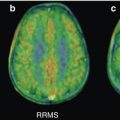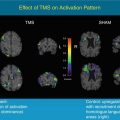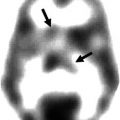Rudi A.J.O. Dierckx, Andreas Otte, Erik F.J. de Vries, Aren van Waarde and Klaus L. Leenders (eds.)PET and SPECT in Neurology201410.1007/978-3-642-54307-4_38
© Springer-Verlag Berlin Heidelberg 2014
38. PET in Epilepsy
(1)
Department of Clinical and Experimental Epilepsy, Institute of Neurology, University College London, Queen Square, London, WC1N 3BG, UK
Abstract
The major drawback in clinical PET imaging is that of specificity: in epilepsy, PET shows both the cause and consequence of seizure activity in the focus and projection area of the seizure onset. This can make treatment decisions for resective surgery difficult.
[18F]FDG PET has been long integrated in presurgical neuroimaging in many centres and proved to be clinically useful in identifying focal glucose metabolic abnormalities.
[1lC]Flumazenil, which delineates γ-aminobutyric acid receptor A (GABA-A) availability, may provide a biochemical marker of epileptogenicity and strengthens the hypothesis that inhibitory mechanisms are disturbed in the epileptic focus. Although [1lC]flumazenil, and other novel PET ligands for opioid and serotonin neurotransmission, showed great potential in selected patient subgroups, these tracers have not yet reached the stage of routine clinical application.
Ultimately, the challenge for PET imaging in epilepsy, like for most CNS diseases, is overcoming drug-resistance due to poor delivery and/or retention of pharmaceuticals across the blood-brain barrier. There is the potential of PET to be relevant for the selection of certain novel treatment strategies, beyond the localisation of the focus for resective surgery.
38.1 Clinical Impact of PET in Epilepsy
Deoxyglucose radiolabelled with 18-fluorine ([18F]FDG) administered to patients interictally is the sole application of PET in widespread routine clinical use in epilepsy. The technique provides a measure of cerebral glucose metabolism, which is reduced in the epileptogenic region interictally, in 60–90 % of patients with temporal lobe epilepsy (TLE). Ictal [18F]FDG PET is unhelpful as cerebral uptake of the radioligand takes place over many minutes post injection.
Unfortunately, the area of hypometabolism demonstrated with [18F]FDG PET is usually considerably larger than the pathological abnormality, site of neuronal loss and epileptogenic zone. In those patients with definitive MRI lesions, the technique adds little. However, its place remains in the presurgical evaluation of patients with non-definitive MRI abnormalities and/or discordant data, in particular patients with normal MRI – both in temporal and neocortical epilepsies and subtle focal cortical dysplasia. Imaging with [18F]FDG PET has shown that patients with TLE who were seizure-free after temporal lobe resection had a greater proportion of hypometabolic area surgically removed than individuals who continued to have seizures (Willmann et al. 2007). This finding raises the possibility of tailoring the extent of resection according to the area of hypometabolism, especially in anatomically complex cases. Such a tailored approach would be challenging, however, as the volume of hypometabolism is often extensive and frequently extends into eloquent cerebral areas. The findings in patients with TLE might simply reflect the possibility that the greater the extent of resection, the greater the chance of seizure remission.
The available evidence for clinical effectiveness of PET is inadequate to reliably inform clinical practice. This is astonishing considering that since the 1980s, [18F]FDG PET has been the imaging workhorse of presurgical evaluations in patients with epilepsy, although over the past 20 years, these imaging techniques have been largely superseded by high-quality MRI. Indeed, FDG PET is redundant if a lesion shown on MRI is concordant with clinical and EEG data (Willmann et al. 2007). The value of FDG PET data is enhanced by voxel-based comparisons of individual patient scans with normative data and coregistration of PET images with MRI scans (Salamon et al. 2008). These advances have helped to decide on placement of intracranial EEG electrodes, but have not yet been shown to improve surgical outcomes. There is a lack of studies evaluating the impact of these tests on clinical decision-making and patient outcomes; only one such study meets this criterion, reporting the impact of imaging (FDG PET) on the decision-making process (O’Brien et al. 2008). Of the 110 patients who received FDG PET, the decision for or against surgery was considered to be influenced by the results of the FDG PET scan in 78 patients (71 %): 48 influenced the decision in favour of surgery and 28 in favour of no surgery, and 2 patients had doubt cast on prior decisions and eligibility for surgery became uncertain. The positive decision predictive value for PET was 65 % (95 % CI 53–77 %) and negative decision predictive value was 60 % (95 % CI 45–72 %). It showed that if the FDG PET result does not lead to a positive or negative decision to undertake surgery, invasive EEG is offered. This strategy appeared the most cost-effective at conventional cost-effectiveness thresholds of £20,000–30,000. When the additional benefits conferred over the longer term for patients who received surgery compared to medical management alone (i.e. the benefits over and above those attributed to the additional success rate of surgery in increasing the probability of patients becoming seizure-free at 1 year) were excluded, medical management appeared to be the more appropriate management strategy for patients in whom the decision to proceed to surgery was still unclear following the results of FDG PET.
38.2 Impact of Novel PET Ligands
The development of specific PET ligands to identify focal abnormalities and, hence, to inform surgical treatment has been a long-term aspiration in epilepsy surgery. Several PET receptor ligands have been used to investigate the neurochemical basis of the epilepsies and have partially entered clinical routine. The aim is to assess neurotransmitter systems that are directly responsible for modulating synaptic activity, specific ligand–receptor relationships that seem to be important for epileptogenesis and spread of epileptic activity and generic mechanisms relevant for the development of pharmaco-resistance.
38.2.1 Imaging GABAergic Neurotransmission
[11C]Flumazenil (FMZ) binds to the γ-aminobutyric acid receptor complex and can identify occult surgically relevant abnormalities. In the context of identifying epileptogenic tissue, binding of [1lC]FMZ was significantly lower in the epileptic focus than in the contralateral homotopic reference region and the remaining neocortex (Savic et al. 1988). It identified occult but surgically relevant abnormalities of benzodiazepine receptors (Ryvlin et al. 1998), and in malformations of cortical development, abnormalities were more extensive than subtle structural abnormality revealed with MRI (Hammers et al. 2001). Reduced binding can be seen at the epileptogenic focus and the seizure onset region, however, in a more restricted distribution than the corresponding area of [18F]FDG hypometabolism, and sometimes also in projection areas (Savic et al. 1995). In addition, the degree of GABA receptor reduction showed a positive correlation with seizure frequency (Laufs et al. 2011). Furthermore, there was a close correlation between time since last seizure and magnitude of change in FMZ binding (Bouvard et al. 2005). Therefore, this method may not only be suitable for noninvasive localisation of the seizure focus but also provides a biochemical marker of epileptogenicity, strengthening the hypothesis that inhibitory mechanisms are disturbed in the epileptic focus. In unilateral hippocampal sclerosis, reduction of binding of [11C]FMZ has been shown to be confined to the hippocampus (Koepp et al. 1996) and to be over and above that caused by neuron loss and hippocampal atrophy (Koepp et al. 1998a). In malformations of cortical development, abnormalities of benzodiazepine receptors, as demonstrated with [11C]FMZ PET, were more extensive than the structural abnormality revealed with MRI (Hammers et al. 2001). Moreover, [11C]FMZ PET was shown to be more accurate than [18F]FDG PET for the detection of cortical regions of seizure onset and frequent spiking in patients with extra-TLE (Muzik et al. 2000), whereas both [18F]FDG and [11C]FMZ PET showed low sensitivity in the detection of cortical areas of rapid seizure spread (Koepp et al. 2000).
Currently, the clinical role of [11C]FMZ for the detection of temporal and extratemporal foci is viewed controversially. Even though [11C]FMZ binding has revealed focal abnormalities in 80 % of patients with refractory TLE and normal high-quality MRI, this method has not been considered consistently helpful in localising epileptic foci (Koepp et al. 2000). In addition, the short half-time of 11C (20 min) hampers the wide use of [11C]FMZ for clinical routine. The possible implementation of [18F]FMZ in clinical routine will most probably provide a more definite answer about the clinical benefit of benzodiazepine receptor imaging (Vivash et al. 2013).
The use of interictal [11C]FMZ PET in patients with idiopathic generalised epilepsy, together with voxel-based morphometry MRI studies, has truly challenged the concept of generalised epilepsies revealing predominantly frontal increases in FMZ binding suggestive of focal microdysgenesis (Koepp et al. 1997; Savic et al. 1994). In a similar vein, the prevailing concept in focal epilepsies of epileptogenic zones, defined “posthum” through seizure freedom following complete resection, has been challenged in a recent analysis of FMZ PET studies. Laufs and colleagues averaged both PET and fMRI data across a group of patients with different sites of seizure onset and identified an area in the human piriform (primary olfactory) cortex that was active in association with interictal EEG spikes and showed reduced FMZ binding associated with increased seizure frequency (Laufs et al. 2011). This region was located in close proximity to the physiologically defined deep piriform cortex from which convulsants are known to initiate temporal lobe seizures, and blockade of glutamate receptors or application of a GABA receptor agonist reduces limbic motor seizures in rodents and nonhuman primates (Piredda and Gale 1985).
38.2.2 Imaging Serotonergic Neurotransmission
One major drawback in clinical imaging is that of specificity. MRI, FDG and FMZ PEt all show both the cause and consequence of seizure activity, in the focus and projection area of the seizure onset. Furthermore, often multiple lesions are detected, and the significance of these changes is unclear.
Alpha[11C]methyl-L-tryptophan (AMT) is an analogue of the essential amino acid tryptophan, the precursor of serotonin. AMT PET was originally developed to study abnormalities of brain serotonin synthesis. Preliminary studies in patients with neocortical epilepsy demonstrated that epileptogenic cortical areas show increased AMT uptake in some patients, even if MRI or FDG PET are non-localising (Fedi et al. 2001; Juhász et al. 2003). An increase in alpha [11C]AMT uptake has been suggested to indicate the epileptic focus in situations where more than one possible focus is present, such as in patients with tuberous sclerosis. In one study, 25 % of children with refractory focal epilepsy and normal MRI had a focal increase in AMT binding, and positive findings had a high specificity for the identification of the epileptic focus (Wakamoto et al. 2008). The sensitivity of AMT PET appears to be below 50 % in non-lesional epilepsy, but its high specificity for detecting the lobe of seizure onset makes it an attractive imaging modality when other, more conventional imaging techniques fail to provide a clear localising information and also in presurgical evaluation of patients for reoperation after a failed surgery (Juhász et al. 2003). Recent studies suggested that increased AMT uptake may be relatively common in patients with epileptogenic cortical malformations (Chugani et al. 2013).
Experimental data in animals indicate that 5-HT1A receptors are located predominantly in limbic areas and that serotonin, via these receptors, mediates an antiepileptic and anticonvulsant effect. The literature on 5-HT1A receptor binding has recently been reviewed in detail (Hammers 2012). 5-HT1A receptors have been investigated with [18F]FCWAY (Toczek et al. 2003). Twelve patients with TLE were correctly lateralised but not localised, including three patients with normal hippocampal volumes. Asymmetry indices for [18F]FCWAY were greater than those for FDG PET or hippocampal volumes.
Another study used the novel 5-HT1A radioligand [18F]MPPF (20-methoxyphenyl-(N-20-pyridinyl)-p-[18F]fluorobenzamidoethylpiperazine), an antagonist of the 5-HT1A receptors, to assess the extent of 5-HT1A receptor binding changes in patients with TLE and hippocampal ictal onset. Patients had TLE of various aetiologies, and all underwent video-EEG evaluation with depth electrodes implanted. Binding was reduced in the epileptogenic areas, and magnitude of decrease was related to both electrophysiological data (greatest in areas of ictal onset and spread) and structural data (greatest in lesions with volume loss, followed by lesions). Binding potential (BP) reductions were found in all nine patients; they corresponded to or included the ictal onset zone in five and propagation areas in two and were maximal in the onset areas but failed to reach significance in two. In four patients, contralateral abnormalities were seen; in one of these patients who was explored with contralateral depth electrodes, one seizure did start contralaterally. [18F]MPPF PET correctly indicated lateralisation in all three patients without lesions on MRI. In patients with normal hippocampal volume, the BP decrease was restricted to the temporal pole (Merlet et al. 2004a). The decrease was more pronounced in the seizure onset zone and in regions where the discharge propagated than in regions where only interictal paroxysms or no epileptic activity was recorded (Merlet et al. 2004b). Therefore, these results indicate that [18F]MPPF binding not only reflects structural changes or neuronal loss.
The reduction in 5-HT1A BP in patients with mesial TLE may be explained, on the one hand, by a decrease in receptor density due to downregulation due to hyperexcitability or, on the other hand, by an increase in endogenous serotonin as a reactional process to modulate hyperexcitability.
Comparison between [18F]FDG and [18F]MPPF PET data showed the clear-cut superiority of the latter for localising visually the epileptogenic area in patients with mesial TLE. The specificity of [18F]FDG PET was lower than that of [18F]MPPF PET, with only 23 % of patients showing hypometabolism restricted to the hippocampus, amygdala and temporal pole, versus 38 % demonstrating such abnormalities with [18F]MPPF PET (Didelot et al. 2008). Taken together, these studies suggest that 5-HT1A receptor PET could play a role in lateralising TLE when other imaging modalities are nonconclusive.
Stay updated, free articles. Join our Telegram channel

Full access? Get Clinical Tree








